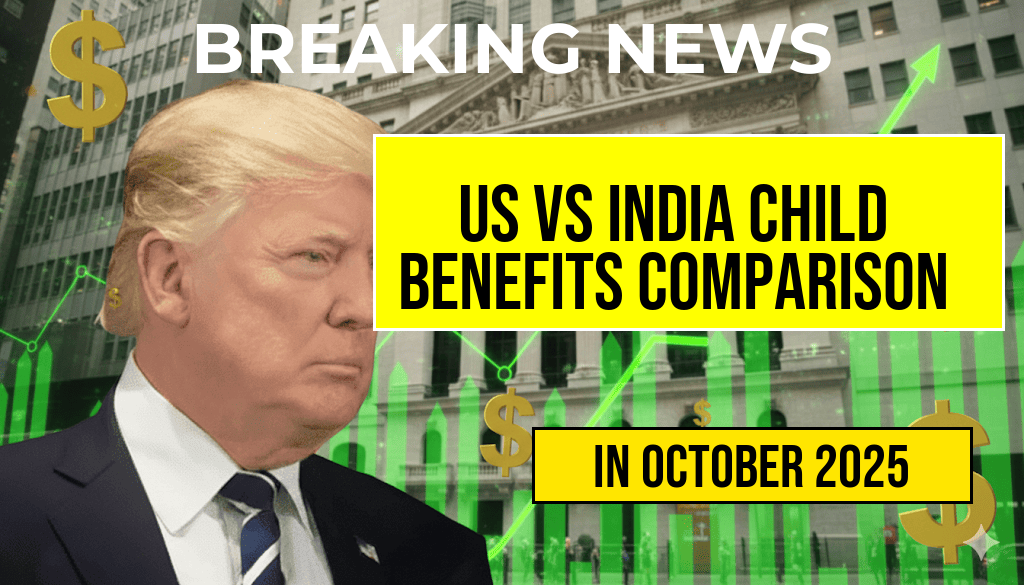Across the globe, governments implement various child benefit programs aimed at alleviating family financial burdens and supporting child development. A striking comparison emerges when examining the amounts allocated in different countries: the United States provides approximately $2,200 per child annually through federal and state programs, while India offers roughly 165,000 Rupees—equivalent to about $2,000—through its national schemes. Despite similar monetary values, these benefits reflect diverse economic contexts, living costs, and social policies. This article explores the nuances behind these figures, the structure of child benefits in both nations, and how they translate into real-world support for families.
Contextual Background of Child Benefits
Child benefit programs serve as essential social safety nets, aiming to improve living standards, promote educational opportunities, and reduce child poverty. While the United States has a fragmented system comprising federal initiatives like the Child Tax Credit and state-level support, India operates a more centralized framework, primarily through schemes such as the Integrated Child Development Services (ICDS) and direct cash transfers. These differing approaches reflect broader economic, cultural, and political priorities.
Financial Figures and Economic Context
| Country | Annual Child Benefit | Equivalent in USD | GDP Per Capita (2023) |
|---|---|---|---|
| United States | $2,200 | $2,200 | $70,000 |
| India | 165,000 Rupees | $2,000 | $2,300 |
In terms of **gross domestic product (GDP) per capita**, the US surpasses India significantly, indicating higher average income levels and living standards. The $2,200 benefit in the US, therefore, represents a smaller proportion of annual income compared to the same monetary value in India—where the average income is substantially lower. This disparity influences how families perceive and utilize these benefits, often making the same amount more impactful in emerging economies.
Structure and Eligibility of Child Benefits
United States
The US primarily offers financial relief through the Child Tax Credit, which has undergone recent expansions. For 2023, eligible families can receive up to $2,000 per qualifying child under age 17, with a portion refundable, meaning families can receive the benefit even if they owe no taxes. The qualification depends on income thresholds, with phase-outs beginning at higher income levels, making the benefit more accessible to middle and upper-income households.
India
India’s approach centers around direct cash transfers and targeted programs aimed at vulnerable populations. The Pradhan Mantri Matru Vandana Yojana and other schemes provide financial assistance to expectant and new mothers, while the Mid-Day Meal scheme supports school-aged children. Direct benefit transfers, such as those under the National Child Benefit Scheme, can reach families with monthly stipends totaling approximately 165,000 Rupees annually, depending on regional eligibility.
Impact and Effectiveness of Child Benefits
While dollar amounts are similar, the actual impact of these benefits varies considerably. In the US, the support can help offset educational costs, healthcare, and childcare expenses, particularly in high-cost urban environments. Conversely, in India, the benefits often serve as critical income support for impoverished families, enabling access to basic necessities such as nutrition, healthcare, and education.
Real-World Outcomes
- United States: Data suggests that expanded Child Tax Credits in recent years have contributed to reductions in child poverty rates, especially among marginalized communities (Center on Budget and Policy Priorities).
- India: Cash transfer programs have demonstrated success in improving child health and school enrollment, particularly in rural regions (World Bank).
Broader Socioeconomic Factors
Economic disparities influence how families leverage child benefits. In wealthy nations like the US, additional support often complements a robust social safety net, including healthcare, education, and housing assistance. In contrast, Indian families rely heavily on direct cash transfers to meet immediate needs, with benefits often serving as lifelines in environments with limited social infrastructure.
Looking Ahead
As both countries continue to evolve their social policies, the focus shifts toward ensuring equitable access and maximizing the benefits’ effectiveness. The US debates ongoing about expanding or restructuring child benefits, while India explores scaling up its programs to reach more vulnerable populations. The core challenge remains: translating monetary support into tangible improvements in children’s well-being across diverse socioeconomic landscapes.
Understanding these differences underscores how economic context, policy design, and cultural priorities shape child benefit programs worldwide. The disparity in nominal amounts—$2,200 in the US versus 165,000 Rupees in India—reflects broader realities of income levels and living costs, illustrating that the true measure of support lies in how these funds are used to foster healthier, more equitable childhoods.
Frequently Asked Questions
What are the main differences between child benefits in the US and India?
The primary difference lies in the amounts and currency offered: the US provides around two thousand two hundred dollars, whereas India offers approximately one hundred sixty-five thousand rupees. Additionally, the benefit structures and eligibility criteria vary based on each country’s social policies.
How does the value of child benefits compare between the US and India?
While the numeric amounts differ significantly due to currency differences, the relative value and purchasing power depend on each country’s cost of living. The Indian benefit, when converted, may provide different support levels compared to the US, reflecting economic contexts.
Are the eligibility criteria for child benefits similar in the US and India?
No, the eligibility requirements differ widely. The US typically offers benefits based on income levels and family circumstances, while India’s programs may target specific income groups or social categories, often with different documentation processes.
What impact do these benefits have on families in each country?
The financial support provided by child benefits can significantly relieve economic burdens for families. In the US, the benefits help cover childcare and education costs, while in India, they can be crucial for basic needs and poverty alleviation.
How do international differences in child benefits reflect each country’s social policies?
The disparities highlight each nation’s approach to social welfare. The US emphasizes targeted financial assistance as part of its social safety net, whereas India’s programs often aim to address broader social issues like poverty reduction and inclusive development.







